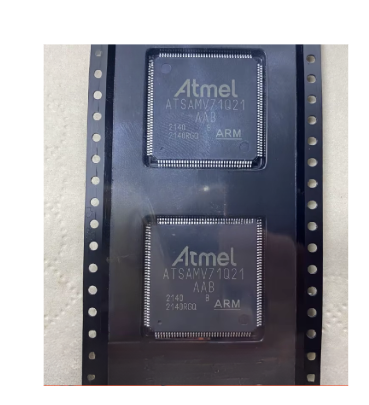Microchip ATSAMV71Q21B-AAB +BOM
The ATSAMV71Q21B-AAB from Microchip is a powerful microcontroller. Based on the Arm® Cortex®-M7 core, it operates at a frequency of up to 300 MHz, enabling efficient computing. It integrates 2048 KB of flash memory and 384 KB of multi-port SRAM, ensuring data storage and fast read-write operations. With a wealth of peripheral interfaces, such as Ethernet and USB, it can meet diverse communication needs. It is widely used in fields like industrial control and automotive electronics, and with its high performance and stability, it helps to realize the functions and upgrade the technologies of related products.
Microchip ATSAMV71Q21B-AAB's Features
Core Performance
- High-performance Core: It adopts the Arm Cortex-M7 core, with an operating frequency of up to 300MHz. It is equipped with a 16KB I-Cache and a 16KB D-Cache, and has an Error Code Correction (ECC) function, which can effectively improve the accuracy and speed of data processing.
- Floating-point Operation and Instruction Set: It integrates a single-precision and double-precision hardware Floating-point Unit (FPU), supports DSP instructions and the Thumb®-2 instruction set, enhancing the computing power and code execution efficiency.
- Memory Protection and Tracking: It is equipped with a Memory Protection Unit (MPU) with 16 regions, which can effectively protect the system memory. At the same time, it has an Embedded Trace Module (ETM), including a Trace Port Interface Unit (TPIU), which is convenient for program debugging and performance analysis.
- Large-capacity Flash: It has a built-in 2048KB of embedded Flash, with a unique identifier and a user signature area, which is convenient for users to store specific data. It also supports various erasing and programming methods.
- High-speed SRAM: It integrates 384KB of multi-port SRAM, which can optimize the system bandwidth and reduce the access delay, meeting the requirements of high-speed data processing.
- Other Storage: It includes Tightly Coupled Memory (TCM), 16KB of ROM, which is used to store the embedded bootloader (UART0, USB) and In-Application Programming (IAP) routines. It also has a 16-bit Static Memory Controller (SMC) that supports a variety of external storage devices.
- Power Management: It integrates an embedded voltage regulator and supports single-power-supply operation. It has functions such as Power-on Reset (POR), Brown-out Detection (BOD), and dual Watchdog, ensuring the safe and stable operation of the system.
- Clock System: It supports quartz or ceramic resonator oscillators. The main oscillator frequency range is 3MHz to 20MHz, and it has a fault detection function. There is also a 12MHz or 16MHz clock for USB operation, and an optional 32.768kHz low-power oscillator for the Real-Time Clock (RTC) or device clock. In addition, it has a 500MHz Phase-Locked Loop (PLL) for the system clock and a 480MHz PLL for USB high-speed operation.
- Other Functions: It integrates a temperature sensor and a dual-port 24-channel Central Direct Memory Access Controller (XDMAC), which is convenient for high-speed data transmission.
- Low-power Characteristics: It supports low-power sleep, wait, and backup modes. In the backup mode, when the RTC, Real-Time Timer (RTT), and wake-up logic are enabled, the typical power consumption can be as low as 1.1μA, making it suitable for applications with strict power consumption requirements.
- Communication Interfaces: It has an Ethernet Media Access Controller (GMAC), supporting 10/100Mbps MII and RMII modes, IEEE® 1588 Precision Time Protocol (PTP) frames and 802.3az Energy-Efficient Ethernet support, as well as Ethernet Audio Video Bridging (AVB) support. It also has a USB 2.0 device/mini host high-speed (USBHS) interface with a data rate of up to 480Mbps, a 4KB FIFO, up to 10 bi-directional endpoints, and supports dedicated DMA. It also includes multiple serial ports (such as USART, UART), I2C interfaces (TWIHS), SPI interfaces, Quad Serial Peripheral Interface (QSPI) interfaces, etc., to meet different communication needs.
- Other Peripherals: A 12-bit ITU-R BT. 601/656 Image Sensor Interface (ISI); two Motor Control Area Network (MCAN) controllers that support Flexible Data Rate (CAN-FD), with SRAM-based mailboxes, supporting time-triggered and event-triggered transmissions; MediaLB® device, supporting the 3-wire mode, with a maximum speed of 1024 x Fs, and supporting MOST25 and MOST50 networks, etc. There are also timers, counters, Pulse Width Modulation (PWM) controllers, Analog Front End (AFE) controllers, Digital-to-Analog (DAC) controllers, Analog Comparator (AC) controllers, etc., which can meet various control and signal processing requirements.
I/O Characteristics: It has up to 114 I/O lines, with external interrupt capabilities (supporting edge or level triggering), debouncing, glitch filtering, and on-chip series resistance termination functions; five Parallel Input/Output (PIO) controllers, which are convenient for connecting and controlling external devices.
Voltage Range: For AEC-Q100 Grade 2 devices, the single-power-supply voltage range is 3.0V to 3.6V; for industrial temperature devices, the single-power-supply voltage range is 1.7V to 3.6V, having good voltage adaptability.
Package Form: It adopts the LQFP144 package, with 144 pins. The package size is 20x20mm, and the pin pitch is 0.5mm, making it convenient for installation and use.
Microchip ATSAMV71Q21B-AAB's Applications
Industrial Control Field
- Motor Control: Equipped with multiple timers, counters, and PWM controllers, such as four three-channel 16-bit Timer/Counters (TC) and two 4-channel 16-bit PWMs, it can achieve precise control of motors. It is suitable for various motor drive scenarios in industrial automation equipment, such as the control of robotic arms in factories and the motors on automated production lines.
- Industrial Automation Monitoring and Control: With its rich communication interfaces, such as Ethernet Media Access Controller (GMAC), multiple serial ports (USART, UART), SPI interface, and I2C interface (TWIHS), etc., it can interact with various sensors, actuators, and other devices for data exchange, enabling real-time monitoring and control of the industrial production process. It plays a crucial role in intelligent factories, industrial Internet of Things (IoT) systems, etc.
- Power Management and Monitoring: The integrated Analog Front End Controller (AFEC), Analog Comparator Controller (ACC), and Digital-to-Analog Controller (DAC) can accurately measure and regulate electrical signals such as voltage and current, and are used in industrial power management systems, power quality monitoring devices, etc.
- Body Control: Meeting the strict requirements for safety and reliability in automotive electronics, it communicates with other automotive electronic control units through the Controller Area Network with Flexible Data Rate (CAN-FD) bus, enabling the control and management of automotive body devices such as door locks, windows, and lights.
- In-vehicle Infotainment System: Supporting the high-speed USB interface (USBHS) and Ethernet interface, it can connect to external storage devices, networks, etc., providing data transmission support for the in-vehicle infotainment system, such as enabling functions like in-vehicle navigation and multimedia playback.
- Automotive Sensor Data Processing: It can process data from various automotive sensors, such as temperature sensors and pressure sensors. With its powerful computing capabilities and rich peripherals, it can perform real-time analysis and processing of sensor data, providing support for the safe driving and performance optimization of vehicles.
- Smart Home Devices: Its low-power consumption characteristics make it suitable for battery-powered smart home devices, such as smart door locks and smart sensors. The rich communication interfaces facilitate the connection of devices to the home network, enabling remote control and data transmission. Users can remotely monitor and control home devices through mobile phones or other smart devices.
- Industrial IoT Nodes: In the industrial Internet of Things, it can be used as an edge node device to collect data from field devices and transmit the data to the cloud or a host computer system for analysis and processing through Ethernet or other communication interfaces, enabling functions such as remote monitoring of industrial devices and fault prediction.
- Wearable Devices: Combining its low-power consumption and rich interface features, it is suitable for wearable devices such as smart watches and fitness trackers. It can process sensor data, such as data from accelerometers and heart rate sensors, and synchronize data with devices like mobile phones through Bluetooth or other wireless communication methods.
- Multimedia Devices: With its high-speed processing capabilities and various interfaces, it can be used in consumer electronic devices such as game consoles and multimedia players, supporting the processing and transmission of data such as images and audio, enhancing the performance and user experience of the devices.
Medical Equipment Field: The 16-bit microcontroller is suitable for some medical devices with high requirements for performance and stability, such as portable medical monitoring devices (such as blood glucose monitors, blood pressure monitors, etc.). Its precise analog signal processing capabilities and reliable communication functions can achieve accurate collection and transmission of physiological data, meeting the strict requirements of medical devices for data accuracy and security.

Microchip ATSAMV71Q21B-AAB's Attributes
| Part Family | SAMV71 | CPU Type | Cortex-M7 |
| MaxSpeed (MHz) | 300 | SRAM (KB) | 384 |
| Temp. Range Min. | -40 | Temp. Range Max. | 105 |
| Operation Voltage Min.(V) | 1.7 | Operation Voltage Max.(V) | 3.6 |
| SPI | 5 -SPI | I2C | 3 |
| UART | 8 | QSPI | 1 |
| Crypto Engine | Yes | Internal Oscillator | 4,8,12Mhz, 32Khz |
| Pin Count | 144 | Secure Boot | No |
Microchip ATSAMV71Q21B-AAB's Datasheet
Microchip ATSAMV71Q21B-AAB's Category-Microcontrollers
In today's digital era, microcontrollers, as a crucial component of embedded systems, are silently driving the operation of countless smart devices. Essentially, a microcontroller is a small computer integrated on a single chip, which closely combines the central processing unit (CPU), memory, and various peripherals to form an efficient and independent computing unit. The CPU, as the "brain" of the microcontroller, is responsible for executing various instructions and controlling the operation process of the device. Memory is divided into volatile random access memory (RAM), which is used to temporarily store operating data, and non-volatile flash memory, which is used to store the device's firmware programs. The peripherals are extremely diverse, including input/output interfaces, timers, counters, analog-to-digital converters, etc. They endow the microcontroller with powerful functions such as interaction with the external world, precise timing, and signal conversion. Microcontrollers have extremely wide applications. In the field of consumer electronics, from smartphones to smartwatches, due to their light weight and low power consumption characteristics, they greatly enhance the battery life and user experience of the devices. In the scenario of industrial automation, they can precisely control motors and sensors to ensure the efficient and stable operation of the production line. In the automotive system, they achieve comprehensive intelligence from engine management to body electronics.
Microchip's ATSAMV71Q21B-AAB is even more an outstanding product among microcontrollers. It is based on the powerful Arm® Cortex®-M7 core, with an operating frequency of up to 300 MHz. Coupled with the hardware floating-point unit and rich instruction set, its computing efficiency is outstanding. The large-capacity flash memory and multi-port SRAM provide a solid guarantee for data storage and high-speed reading and writing. With rich peripheral interfaces covering Ethernet, USB, various serial ports, etc., it can easily meet different communication needs. From the harsh environment of industrial control to the complex systems of automotive electronics, and then to the interconnection of Internet of Things devices, the ATSAMV71Q21B-AAB, with its excellent performance, provides stable and powerful support for various applications, continuously promoting the technological innovation and development of related fields.











 Wishlist (0 Items)
Wishlist (0 Items) 